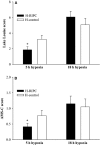Remote ischemic preconditioning delays the onset of acute mountain sickness in normobaric hypoxia
- PMID: 25742960
- PMCID: PMC4393159
- DOI: 10.14814/phy2.12325
Remote ischemic preconditioning delays the onset of acute mountain sickness in normobaric hypoxia
Abstract
Acute mountain sickness (AMS) is a neurological disorder occurring when ascending too fast, too high. Remote ischemic preconditioning (RIPC) is a noninvasive intervention protecting remote organs from subsequent hypoxic damage. We hypothesized that RIPC protects against AMS and that this effect is related to reduced oxidative stress. Fourteen subjects were exposed to 18 hours of normoxia (21% oxygen) and 18 h of normobaric hypoxia (12% oxygen, equivalent to 4500 m) on different days in a blinded, randomized order. RIPC consisted of four cycles of lower limb ischemia (5 min) and 5 min of reperfusion, and was performed immediately before the study room was entered. A control group was exposed to hypoxia (12% oxygen, n = 14) without RIPC. AMS was evaluated by the Lake Louise score (LLS) and the AMS-C score of the Environmental Symptom Questionnaire. Plasma concentrations of ascorbate radicals, oxidized sulfhydryl (SH) groups, and electron paramagnetic resonance (EPR) signal intensity were measured as biomarkers of oxidative stress. RIPC reduced AMS scores (LLS: 1.9 ± 0.4 vs. 3.2 ± 0.5; AMS-C score: 0.4 ± 0.1 vs. 0.8 ± 0.2), ascorbate radicals (27 ± 7 vs. 65 ± 18 nmol/L), oxidized SH groups (3.9 ± 1.4 vs. 14.3 ± 4.6 μmol/L), and EPR signal intensity (0.6 ± 0.2 vs. 1.5 ± 0.4 × 10(6)) after 5 h in hypoxia (all P < 0.05). After 18 hours in hypoxia there was no difference in AMS and oxidative stress between RIPC and control. AMS and plasma markers of oxidative stress did not correlate. This study demonstrates that RIPC transiently reduces symptoms of AMS and that this effect is not associated with reduced plasma levels of reactive oxygen species.
Keywords: AMS; high altitude; oxidative stress; prevention; reactive oxygen species.
© 2015 The Authors. Physiological Reports published by Wiley Periodicals, Inc. on behalf of the American Physiological Society and The Physiological Society.
Figures


Similar articles
-
Remote ischemic preconditioning does not prevent acute mountain sickness after rapid ascent to 3,450 m.J Appl Physiol (1985). 2017 Nov 1;123(5):1228-1234. doi: 10.1152/japplphysiol.00505.2017. Epub 2017 Aug 10. J Appl Physiol (1985). 2017. PMID: 28798201 Clinical Trial.
-
Effects of acetazolamide combined with remote ischemic preconditioning on risk of acute mountain sickness: a randomized clinical trial.BMC Med. 2024 Jan 2;22(1):4. doi: 10.1186/s12916-023-03209-7. BMC Med. 2024. PMID: 38166913 Free PMC article. Clinical Trial.
-
Repeated remote ischaemic preconditioning can prevent acute mountain sickness after rapid ascent to a high altitude.Eur J Sport Sci. 2022 Aug;22(8):1304-1314. doi: 10.1080/17461391.2021.1927197. Epub 2021 May 23. Eur J Sport Sci. 2022. PMID: 33977839 Clinical Trial.
-
Remote ischemic preconditioning for prevention of high-altitude diseases: fact or fiction?J Appl Physiol (1985). 2015 Nov 15;119(10):1143-51. doi: 10.1152/japplphysiol.00156.2015. Epub 2015 Jun 18. J Appl Physiol (1985). 2015. PMID: 26089545 Review.
-
Remote ischemic preconditioning: a novel protective method from ischemia reperfusion injury--a review.J Surg Res. 2008 Dec;150(2):304-30. doi: 10.1016/j.jss.2007.12.747. Epub 2008 Jan 22. J Surg Res. 2008. PMID: 19040966 Review.
Cited by
-
Closing the loop: autonomous intelligent control for hypoxia pre-acclimatization and high-altitude health management.Natl Sci Rev. 2025 Mar 8;12(5):nwaf071. doi: 10.1093/nsr/nwaf071. eCollection 2025 May. Natl Sci Rev. 2025. PMID: 40309344 Free PMC article. Review.
-
The Hen or the Egg: Impaired Alveolar Oxygen Diffusion and Acute High-altitude Illness?Int J Mol Sci. 2019 Aug 22;20(17):4105. doi: 10.3390/ijms20174105. Int J Mol Sci. 2019. PMID: 31443549 Free PMC article. Review.
-
Role of remote ischemic preconditioning against acute mountain sickness during early phase.Physiol Rep. 2015 Aug;3(8):e12499. doi: 10.14814/phy2.12499. Physiol Rep. 2015. PMID: 26265758 Free PMC article. No abstract available.
-
Response to the letter: role of remote ischemic preconditioning against acute mountain sickness during early phase by Sikri and Chawla.Physiol Rep. 2015 Aug;3(8):e12498. doi: 10.14814/phy2.12498. Physiol Rep. 2015. PMID: 26265757 Free PMC article. No abstract available.
-
A critical review of mechanisms regulating remote preconditioning-induced brain protection.J Appl Physiol (1985). 2015 Nov 15;119(10):1135-42. doi: 10.1152/japplphysiol.00169.2015. Epub 2015 May 7. J Appl Physiol (1985). 2015. PMID: 25953834 Free PMC article. Review.
References
-
- Ainslie PN. Subudhi AW. Cerebral blood flow at high altitude. High Alt. Med. Biol. 2014;15:133–140. - PubMed
-
- Ali ZA, Callaghan CJ, Lim E, Ali AA, Nouraei SA, Akthar AM, et al. Remote ischemic preconditioning reduces myocardial and renal injury after elective abdominal aortic aneurysm repair: a randomized controlled trial. Circulation. 2007;116:I98–I105. - PubMed
-
- Auchampach JA, Jin X, Moore J, Wan TC, Kreckler LM, Ge ZD, et al. Comparison of three different A1 adenosine receptor antagonists on infarct size and multiple cycle ischemic preconditioning in anesthetized dogs. J. Pharmacol. Exp. Ther. 2004;308:846–856. - PubMed
-
- Bailey DM. Davies B. Acute mountain sickness; prophylactic benefits of antioxidant vitamin supplementation at high altitude. High Alt. Med. Biol. 2001;2:21–29. - PubMed
-
- Bailey DM, Kleger GR, Holzgraefe M, Ballmer PE. Bartsch P. Pathophysiological significance of peroxidative stress, neuronal damage, and membrane permeability in acute mountain sickness. J. Appl. Physiol. 2004;96:1459–1463. - PubMed
LinkOut - more resources
Full Text Sources
Other Literature Sources
Medical

